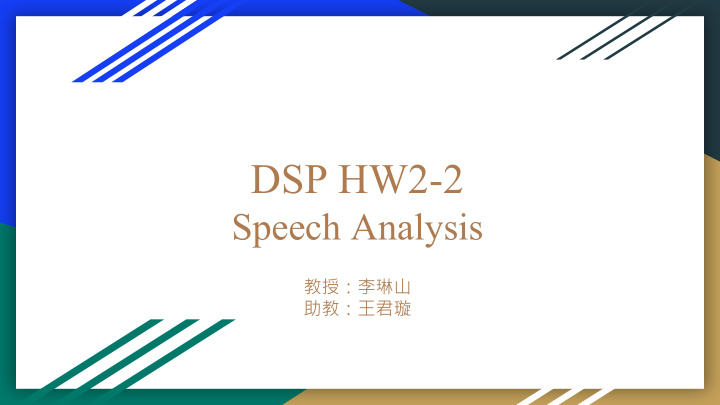



DSP HW2-2 Speech Analysis 教授:李琳山 助教:王君璇
Outline 1. Introduction 2. Praat 3. Homework Problems 4. Submission Requirements
Introduction ● Analyze speech signal from spectrogram ● Try to distinguish different initials( 聲母 ) and finals( 韻母 ) on spectrogram. ● Right-Context-Dependent Initial Final (RCDIF) t_i for ㄊ followed by finals starting with 一 ex 1 : ㄊㄧ = t_i i ex 2 : ㄊㄚ = t_a a
Introduction ● classification of consonants 爆破音/塞音 ㄅㄆㄉㄊㄍㄎ Plosive/Stop 擦音 ㄈㄏㄒㄕㄙ Fricative 塞擦音 ㄐㄑㄓㄔㄗㄘ Affricate 鼻音 ㄇㄋ Nasal ● classification of vowels 單母音 ㄧㄨㄩㄚㄛㄜㄦ Monophthong 雙母音 ㄞㄟㄠㄡ Diphthong
Introduction Some useful information about labeling. ● “sil” for silence. ● “sp” for short pause. ● fricative/affricate initials do not contain voicing parts. ● plosive initials contain closure or aspiration period.
Some files you need 1. Phonetic class table ( 聲韻母表 ): http://speech.ee.ntu.edu.tw/homework/DSP_HW2-2/phonetic_class.pdf 2. Syllable table ( 標註模式 ): http://speech.ee.ntu.edu.tw/homework/DSP_HW2-2/syllable.txt 3. Audio data & FAQ: http://speech.ee.ntu.edu.tw/homework/DSP_HW2-2/
Praat 1. Download http://www.fon.hum.uva.nl/praat/ 2. How to read a wave file 3. How to use it 4. How to label
Praat
Praat - Read from file (.wav file)
Praat - click View & Edit
Praat - Time and Frequency Domain
Praat - Pitch 音高 ( pitch -> Show pitch )
Praat - Intensity 音量( Intensity -> Show Intensity )
Praat - Formant 共鳴 ( Formant -> Show formants )
Praat - Reminder 1. Intensity: power of all frequency components Two acoustic signals may have the same intensity but different frequency components. 2. Formant: acoustic resonance, measured by the peak in the frequency spectrum You should not trust the formant detection output for unvoiced initials.
Praat - Label a wave file ( Annotate -> To TestGrid ) 1. 2.
Praat - Label a wave file ● Create one interval tier named RCDIF ● No point tiers
Praat - Label a wave file ● With BOTH objects selected ● click View & Edit
Praat - Label a wave file
Praat - Label a wave file ● Click on spectrogram for your boundary ● Add the boundary by clicking the small circle Remove by choosing “Boundary/Remove” ● Drag you boundaries to be more accurate ● Click between your boundary and type in your label (according to the “Syllable table”) Listen to your label by clicking the number (interval time) below it
Praat - After labeling
Praat - Save your Label file ● Save your TextGrid object as short text file File should be “.TextGrid” not “.Collection”
Report - Part 1 (20%) ● Choose your wave files from directories according to your student ID ( https://goo.gl/ero6Ka ). ● You must submit at least 5 fully labeled TextGrid files ( along with their wave files ). ● These 5 files should contain the initial/final labels you use in part 2.
Report - Part 2 (30%) ● Choose at least 2 initials from the 4 classes (Plosive, Fricative, Affricate, Nasal) ● For each of these 8 initials, create a table that contains at least 2 screenshots of its label. ● Please show intensity and formant.
Part 2 - example : Plosive b ( ㄅ ) Phonetic Class Plosive b( ㄅ )
Part 2 - example : Plosive p ( ㄆ ) Phonetic Class p Plosive p( ㄆ )
Part 2 - Useful tips ● Zoom in and Zoom out. ● show all or selection part in Praat by clicking the buttons on the lower-left corner of spectrograms. ● In your chosen directory. “NTU_XXXXX_phn2file” lists all files containing each phone “NTU_XXXXX_file2phn” lists all phones contained in each file
Report - Part 3 (50%) 1. (20%) What are the consistencies of the spectrogram in each phonetic class? (Plosive, Fricative, Affricate, Nasal) 2. (10%) Is the boundary between neighboring initial and final clear? What is the benefit of using “right-context dependent” initial model (ex: sh_a) instead of pure initial model (ex: sh) to model initials?
Report - Part 3 (50%) 3. (10%) What are the differences when pronouncing ㄅ & ㄆ ? How can you tell the differences in spectrogram for ㄅ & ㄆ ? (You may also want to compare ㄉ & ㄊ , ㄍ & ㄎ respectively) 4. (10%) Take a look at the spectrogram of finals. Is there any simple rules to discriminate initials from finals provided only spectrogram?
Report - Bonus (10%) ● The following is a speech analysis plot for a Chinese word composed of 4 characters. Each character is composed of an initial and a final. ● Guess what the word is and describe your reasoning. (Score: reasoning 8%, correct answer 2%) ● If you cannot figure out the word, you can guess the phonetic class or initial/finals. For example, your answer can be “l_i, i, sic_a, au” or “plosive, diphthong, plosive, monophthong”.
Report - Bonus (10%) ● Hint: it’s a movie name which published in 2019 !
Submission Requirements 1. 5 TextGrid files or more (each along with its wave file). the “.TextGrid” & “.wav” filenames should be the same. 2. hw2-2_bXXXXXXXX.pdf Answer the questions for part 2, 3 & bonus.
Submission Requirements 3. Put those 11 files in a folder, compress the folder to 1 zip file and upload it to CEIBA. ● Folder name should be bXXXXXXXX (e.g. b04901000) ● .zip only ● 20% of the final score will be taken off for wrong format
If you have any problem… ● Look up the Praat introduction website. http://www.fon.hum.uva.nl/praat/manual/Intro.html ● Check the FAQ
Contact TA ● email : ntudigitalspeechprocessingta@gmail.com title: [HW2-2] Problem Description ● Office Hour: Monday 14:30-15:30 電二 531 王君璇 (Please send an email before coming!)
Homework 2 ● Your can submit either HW 2-1 (HMM Training and Testing) HW 2-2 (Speech Analysis) ● You can also submit both ● The higher grade of the two will count as your final score for HW2
Homework 2 ● Deadline: 2019/5/3 23:59:59 ● Late Penalty: 10% off every 24 hours after deadline (less than 24 hours will be viewed as 24 hours). ● Submission after 3 days will get zero point.
Recommend
More recommend